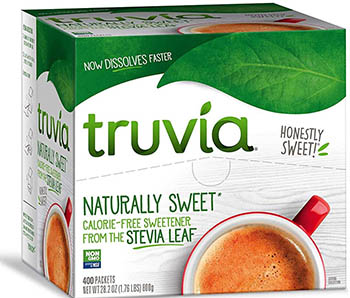Is erythritol safe? Is this sweetener really calorie-free? Is it really natural? Is it better than stevia? Will it help with fat loss? A reader asked, and today’s Burn the Fat Blog post answers in detail, based on science.
Q: Hey Tom, I was looking to use stevia as a natural sweetener with little or no calories. I noticed that Splenda, which used to be only a Sucralose artificial sweetener now has Splenda Naturals which is made with stevia leaf extract. But I looked on the label and I saw the first ingredient was erythritol and stevia leaf extract was second. I have two questions about erythritol. First I was wondering, do you know if erythritol is safe, and has that been confirmed with scientific studies? And second I was wondering, is this really calorie-free or is seeing zero calories on the label one of those legal loopholes?
 A: Years ago, I wrote a post about some of the sugar alcohols that were being used in a lot of protein bars at the time. Readers had been wondering whether the carbs and calories counted or they weren’t absorbed.
A: Years ago, I wrote a post about some of the sugar alcohols that were being used in a lot of protein bars at the time. Readers had been wondering whether the carbs and calories counted or they weren’t absorbed.
In that previous article, I mentioned how a sugar alcohol like xylitol may have less than 4 calories per gram, so it’s less caloric than regular sugar. However, studies showed that the calories are metabolizable by your digestive system, so while xylitol may have only 2.4 calories per gram instead of 4 like most carbs, those calories still count.
Erythritol on the other hand, really is almost calorie free, yet quite sweet. That’s one of the reasons we’ve been seeing erythritol appear more and more in all kinds of sugar replacement products and I was interested in researching this in more depth. That’s true not only out of scientific curiosity but also because I do use erythritol myself sometimes.
In some of my recipes, I use a light brown sugar that has 75 percent fewer calories than regular brown sugar but still tastes almost exactly the same. They pull that off because it’s made with some real brown sugar but it’s blended with erythritol. Many companies make similar products. Truvia is another popular brand.
I’ve also noticed how many spoonable or packet sweeteners use erythritol as the main ingredient and stevia as the secondary ingredient. I use them myself to lightly sweeten oatmeal, nonfat Greek yogurt protein pudding, coffee and a few other meals I eat, including some of my dessert recipes. This mixing of sweeteners is a common practice with other products as well. For example, erythritol is sometimes combined with monk fruit.
Pure stevia is widely available, but some people find that it has an aftertaste or may seem slightly bitter. This might be one of the reasons some companies mix two sweeteners like erythritol and stevia.
“Natural” and “artificial” sweeteners
It’s interesting how the majority of people seem certain that stevia is safe and healthy and that non-nutritive (artificial) sweeteners like aspartame and Sucralose are not, regardless of what scientific evidence says. That’s largely because stevia is considered natural and so it comes with a health halo. (Green boxes included!)
Many sweeteners combine erythritol with stevia, and even if the primary ingredient is erythritol, they are more commonly advertised as a “natural” stevia product. I found that interesting as well and suspect that’s another reason the sweeteners are combined. Stevia is perceived as natural and people might not be sure about erythritol yet, so the stevia angle could help with marketing to the health conscious consumer.
As a tangent, some people report side effects like headaches from using aspartame, and recent research has suggested that the artificial sweetener Sucralose might disrupt the gut microbiome, though findings are not conclusive. With that said, non-nutritive sweeteners are among the most researched consumable products in the world, they have been critically evaluated by the US Food and Drug Administration, The European Food Safety Authority, and Codex Alimentarius. Almost the entire scientific community says they are safe and well tolerated.
Despite the consensus that non-nutritive sweeteners are not harmful in quantities that humans would normally consume, many people still don’t seem to trust them, and a lot of it has to do purely with that word “artificial.” That’s why they are looking for “natural” alternatives.
It doesn’t hurt to look for natural sweeteners to err on the side of healthy caution. One simply needs to keep in mind that the word natural is used as a marketing term, and many people get pulled into eating foods that really aren’t that healthy or helpful for weight control because the word natural puts that health halo over them.
Many people also fall prey to the naturalistic fallacy, an error in critical thinking where a person believes because something is natural, it’s always safe, and if something is not natural, it’s always unsafe. Usually closer to the truth is that it’s the dose that makes a poison. Many completely natural substances can make you sick or kill you if you consume a large enough dose, while artificial ingredients in food, consumed in small doses, may be completely harmless.
But I’ve digressed. Usually I find that people have already made up their minds about artificial sweeteners one way or the other, and it’s pretty clear that the marketplace has already voted, so back to erythritol.
Some people, having sworn to minimize unhealthy and high-calorie refined sugar and being spooked by artificial sweeteners, become interested in erythritol, but it almost seems too good to be true. It’s advertised as natural, safe, calorie-free and tastes almost exactly like sugar. What’s the deal?
After digging into the research, Here’s what I found:
What is erythritol and where does it come from?
Erythritol is a type of carbohydrate. Chemically, it is a four-carbon sugar alcohol. There are several kinds of sugar alcohols. Others include xylitol, sorbitol, maltitol, lactitol and mannitol. Most of them serve as sweeteners in reduced-sugar or sugar-free food products or as powders that are added directly to food and drinks.
Sugar alcohols, including erythritol, are found in small amounts in whole foods, especially in fruits and vegetables such as grapes, peaches, pears, and watermelon, which is why people refer to them as being natural. They also occur naturally in wine, beer, and soy sauce.
There is so little naturally-occurring erythritol in the fruits and fermented foods mentioned above, it is not extracted from them. In the manufactured type used in food products and sweetener packets, the erythritol is produced when yeast ferments the glucose or sucrose that comes from a starch, usually corn. The industrially made erythritol is chemically identical to the erythritol that comes from food and is processed in the body the exact same way.
The granulated or powdered erythritol you spoon from a jar or get from a packet comes from natural sources, but it is processed. Therefore, it’s somewhat of a misnomer to say erythritol from a sweetener packet is natural. Nevertheless, because it is derived from a natural source, the FDA allows the word natural to be used on the label.
Chemically speaking, all sugar alcohols are partly similar to alcohol, as the name implies, but they’re not the same as alcoholic beverages, as they contain no ethanol. Part of the molecule is also similar to sugar, again as the name also implies.
Because of its molecular structure, erythritol stimulates your tongue’s sweet taste receptors so you instantly realize you’re eating something sweet. Erythritol is only 60% to 80% as sweet as sugar, but it does taste very similar and it has no discernible aftertaste. It also gives a mild cooling sensation like you might experience sucking on a mint candy.
I’ve seen conflicting advice on this in cooking circles, but given that it’s only about 70% as sweet as sugar, you might substitute it for real sugar in a 1 part sugar to 1 1/3 part erythritol ratio if you wanted the same sweetness. Because erythritol is less sweet, this is another reason it’s often mixed with other sweeteners that are stronger.
Does Erythritol have calories?
Among the sugar alcohols, erythritol is quite unique. The first thing, and of major interest to dieters, is that it has virtually no metabolizable calories, though it’s not entirely calorie-free.
A gram of carbohydrate contains about 4 calories. Regular white table sugar therefore, being a carbohydrate, has 4 calories per gram. Sugar alcohols contain less gross energy to begin with, usually 1.5 to 3 calories per gram. Xylitol for example has 2.4 calories per gram. Sorbitol has 2.6 and mannitol 1.6. Erythritol contains only 0.2 to 0.4 calories per gram. Because the calories are so low, the official FDA labelling guidelines round it down to zero.
But erythritol is different than the other sugar alcohols in that 90% of it is quickly absorbed from the intestines, then excreted in the urine with none of the calories metabolized en route. Only 10% of it makes it to the colon. There, the bacteria can ferment it, making some of the caloric energy available. However, at least one study has shown that erythritol is more resistant to fermentation by bacteria in the colon, so even this remaining 10% may not all be metabolized either. This is why we can say the metabolizable calories in erythritol are legitimately almost zero.
In the case of a sweetener like regular Splenda (the yellow packets), it’s a different story. If you look at the label you see there are three ingredients not one: dextrose, maltodextrin, and Sucralose. Sucralose is the non-nutritive sweetener. Maltodextrin is a processed carbohydrate usually made from corn that’s easily absorbed and digested. Dextrose is an added sugar that has 3.4 calories per gram. Sucralose is 600 times sweeter than sugar, so only a tiny amount is needed and the rest of the powder is the other two ingredients. Therefore, each packet of sweetener is not really calorie free. FDA laws simply allow the label to say zero calories because the amount is so minimal. Granted, the calories are so low, they have little impact on energy balance, but they’re there despite the label saying there are none, and your body can absorb them.
But enough about calories and the obvious implications for weight loss. What about health?
Erythritol and health
The fact that erythritol is not metabolized in the body is also why it does not affect plasma glucose or insulin concentrations. For this reason, doctors and dietitians often approve of erythritol as a sugar replacement for people with diabetes or issues related to metabolic syndrome, including people who are overweight.
In animal studies involving diabetic rats, erythritol acted as an antioxidant, which might reduce damage to blood vessels caused by high blood sugar levels. A study on human adults with type 2 diabetes found that consuming 36 grams of erythritol daily for a month improved their blood vessel function. It was assumed this could reduce risk for heart disease.
A recent study also found that replacing sugars like sucrose, glucose and fructose with erythritol could improve blood pressure after a meal. Additional studies show that erythritol has no effect on cholesterol or triglycerides either.
Experts are hesitant to promote the use of erythritol for heart health, but studies like these suggest that if there is any effect on cardiovascular health it’s not negative. No negative effects have been found on the gut microbiome either.
Erythritol does get good press when it comes to dental health. A major negative of excessive refined sugar intake is cavities and tooth decay. Some of the bacteria in the mouth feed off sugar for energy, releasing acids in the process and eroding the tooth enamel. These bacteria can’t use sugar alcohols for energy however, and this is why sugar alcohols like erythritol and xylitol are used in products that are said to be tooth friendly.
One study found that both xylitol and erythritol directly suppress the growth of mouth bacteria. Another study, spanning three years, found that erythritol in particular was protective and even more so than xylitol or sorbitol. This finding was confirmed in a later research review.
Not all of the research on human health has been positive. There was a single study, published in 2017 that linked high blood erythritol levels to fat gain in college students. This lead to some negative press for erythritol which you might find if you Googled the topic. However, this study did not show cause and effect. Furthermore, it was not even analyzing the effect of consuming erythritol as a sweetener, it was looking at the endogenous production of erythritol from glucose. There are no studies linking consumption of erythritol as a sweetener to adiposity.
The safety of erythritol has been researched in earnest. In studies where erythritol was mixed into the diet in concentrations as high as 20%, it was declared safe, including in tests that specifically looked at toxicity, carcinogenicity, and reproductive hazards. Scientists say erythritol is well-tolerated and has no toxicological effects even with high dose exposure. As mentioned earlier, erythritol, even in large amounts, passes through the body and is excreted in the urine without any metabolic change. The FDA and the World Health Organization (WHO) both say erythritol is safe.
Side effects of sugar alcohols
There has been one erythritol side effect reported. In large doses, it may cause bloating, digestive discomfort and flatulence in some people. This is a dose dependent side effect, so most people can use erythritol in small amounts with no issues. As the dose increases, some individuals may start to notice the problem.
Why might erythritol cause digestive upset? The 10% of it that’s not absorbed into the bloodstream and excreted through urine travels through your digestive system unchanged. Once it reaches the colon, it’s fermented by the bacteria that reside there and that’s what may produce gas.
There are no official guidelines for a maximum tolerable amount of erythritol, but studies did show that consuming up to .45 grams per pound (that’s 1 gram per kilogram) of body weight is very well tolerated. So if you weighed 150 pounds, you could handle 68 grams of erythritol in a day. That’s over 13 teaspoons.
Unless you’re using very large amounts in a single day, it’s not likely to cause problems. Furthermore, the amount of erythritol that actually reaches the colon is by far the lowest of all the sugar alcohols, so erythritol is the sugar alcohol least likely to cause gastrointestinal distress.
With that said, some people have preexisting digestive issues, so individual tolerance to erythritol, as with many foods, can vary.
Here’s the bottom line about erythritol, as it pertains to calories, health and safety:
If a food contains caloric energy, but the calories can’t get absorbed by your body and they simply pass right through, then the calories don’t count, or we can simply say for practical purposes, that food has no calories.
That means if you were using regular sugar which has 4 calories per gram and you replace it with a non-caloric sweetener such as erythritol (or erythritol combined with stevia or monk fruit and so on), that should have value for helping with weight control.
It’s normal for people to be a little fearful about various sweeteners, but based on scientific research, erythritol does not appear unhealthy. It may in fact may even offer some health benefit especially when it’s been swapped for refined sugar.
According to science, if you use it in reasonable amounts, it appears perfectly safe. If you use it in huge amounts there’s a possibility of side effects, but the worst case is probably just gas or an upset stomach.
I haven’t seen any science that suggests erythritol is bad for you. Compared to years ago, when it was mostly deciding between pure refined sugar or artificial sweeteners, it actually looks like a pretty good option today.
If there’s any down side to using sweeteners, the only other thing that comes to mind is the possibility that using a lot of sugar alcohol-sweetened foods could sharpen your sweet tooth. That might make it more difficult to avoid calorie-containing sweet foods in the future. I think there’s something to be said for training your tastebuds to appreciate only lightly sweetened foods and not use a ton of the stuff just because it’s calorie-free.
Tom Venuto,
Founder, Burn the Fat Inner Circle
Author, Burn the Fat, Feed the Muscle

Tom Venuto is a natural bodybuilding and fat loss expert. He is also a recipe creator specializing in fat-burning, muscle-building cooking. Tom is a former competitive bodybuilder and today works as a full-time fitness coach, writer, blogger, and author. In his spare time, he is an avid outdoor enthusiast and backpacker. His book, Burn The Fat, Feed The Muscle is an international bestseller, first as an ebook and now as a hardcover and audiobook. The Body Fat Solution, Tom’s book about emotional eating and long-term weight maintenance, was an Oprah Magazine and Men’s Fitness Magazine pick. Tom is also the founder of Burn The Fat Inner Circle – a fitness support community with over 52,000 members worldwide since 2006. Click here for membership details
Scientific References:
Arrigoni, E et al, Human gut microbiota does not ferment erythritol, British Journal of Nutrition, 94(5):643-6, 2005.
Beaugerie L, et al. Digestion and absorption in the human intestine of three sugar alcohols. Gastroenterology. 1990 Sep;99(3):717-23.
Bernt WO, et al, Erythritol: a review of biological and toxicological studies. Regul Toxicol Pharmacol 24:S191-7, 1996.
Decock P, et al, Erythritol Is More Effective Than Xylitol and Sorbitol in Managing Oral Health Endpoints International Journal of Dentistry, 2016:2016.
Flint N et al, Effects of erythritol on endothelial function in patients with type 2 diabetes mellitus: a pilot study, Acta Diabetol, 51(3):513-6, 2014.
Gertjan J M et al, Erythritol is a sweet antioxidant, Journal of Nutrition, 26(4):449-58, 2010.
Hiele M et al, Metabolism of erythritol in humans: comparison with glucose and lactitol. Br J Nutr. 69(1):169-176. 1993
Hootman, K, Erythritol is a pentose-phosphate pathway metabolite and associated with adiposity gain in young adults, Proc Natl Acad Sci U S A, 114(21):E4233-E4240, 2017.
Lina, B et al, Chronic toxicity and carcinogenicity study of erythritol in rats, Regul Toxicol Pharmacol, 24(2 Pt 2):S264-79. 1996.
Livesey G. Health potential of polyols as sugar replacers, with emphasis on low glycaemic properties. Nutrition Research Reviews, 16: 163-191 Cambridge University Press, 2003
Mäkinen KK, Gastrointestinal Disturbances Associated with the Consumption of Sugar Alcohols with Special Consideration of Xylitol. Int J Dentistry, 2016:5967907, 2016.
Munro I, et al, Erythritol: an interpretive summary of biochemical, metabolic, toxicological and clinical data, Food Chem Toxicol, 36(12):1139-74, 1998.
Noda K et al, Serum glucose and insulin levels and erythritol balance after oral administration of erythritol in healthy subjects, Eur J Clin Nutr, 48(4):286-92, 1994.
Pham H, et al, Acute Effects of Nutritive and Non-Nutritive Sweeteners on Postprandial Blood Pressure, 11:8, 1717, 2019.
Regnat K, Mach RL, Mach-Aigner AR. Erythritol as sweetener – wherefrom and whereto? Appl Microbiol Biotechnol. 102(2):587-595, 2018.
Ruiz-Ojeda FJ, Effects of Sweeteners on the Gut Microbiota: A Review of Experimental Studies and Clinical Trials, Advanced Nutrition, 10(Suppl 1): S31-S48, 2019.
Storey, D et al, Gastrointestinal tolerance of erythritol and xylitol ingested in a liquid. Eur J Clin Nutr 61, 349-354 2007.







Leave A Comment